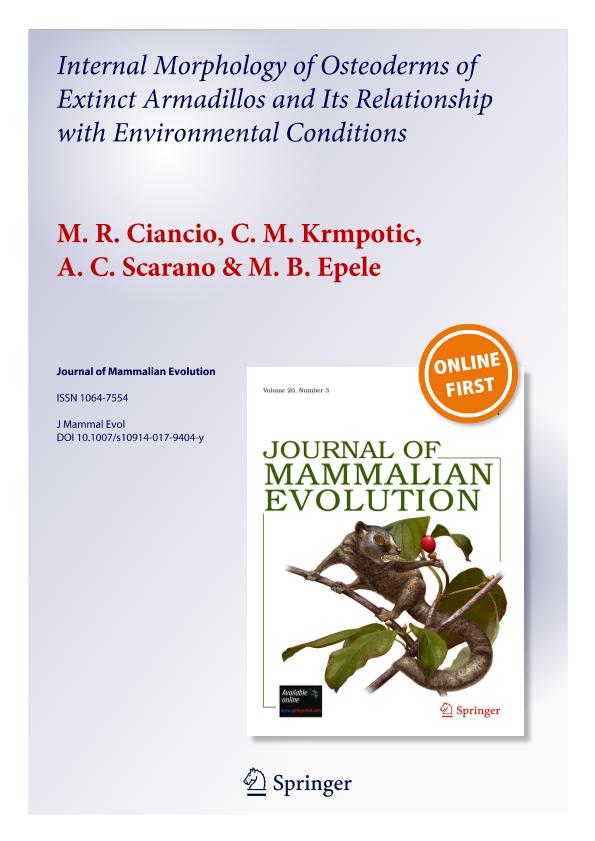Mostrar el registro sencillo del ítem
dc.contributor.author
Ciancio, Martin Ricardo

dc.contributor.author
Krmpotic, Cecilia Mariana

dc.contributor.author
Scarano, Alejo Carlos

dc.contributor.author
Epele, María Bernarda

dc.date.available
2018-04-06T17:44:40Z
dc.date.issued
2017-07
dc.identifier.citation
Ciancio, Martin Ricardo; Krmpotic, Cecilia Mariana; Scarano, Alejo Carlos; Epele, María Bernarda; Internal Morphology of Osteoderms of Extinct Armadillos and Its Relationship with Environmental Conditions; Springer; Journal of Mammalian Evolution; 7-2017; 1-13
dc.identifier.issn
1064-7554
dc.identifier.uri
http://hdl.handle.net/11336/41175
dc.description.abstract
The most complete and continuous fossil record of armadillos is composed mostly by isolated osteoderms, frequently found in paleontological and archaeological sites that bear continental South American mammals. Their external morphology has been used to define several species. In the last decade, many authors have focused on the internal structure of vertebrate osteoderms using histological and paleohistological studies. These studies allowed identification of useful features in systematic and phylogenetic contexts. In armadillos, osteoderms are constituted by compact bone tissue (primary and secondary osteons, and concentric layers or lamellae) that delimits cavities, which could contain different soft tissues (adipose tissue, hair follicles, bone marrow, and sweat and sebaceous glands). Traditional paleohistological techniques have allowed the recognition of homologous cavities to those found in osteoderms of current species and from comparison deduce which kind of tissue could had occupied them. We have recently utilized 3D reconstructions in osteoderms of extant species of armadillos to analyze the micromorphology, disposition, and the relationship of different cavities and understand them in depth. Here, we present the results of the application of paleohistology and microtomography in osteoderms of representatives of diferent taxa of extinct Dasypodidae (Astegotheriini, Stegotheriini, ?Utaetini,? Euphractini, Eutatini), which allowed us to compare homologous structures based on their three-dimensional reconstruction. The results, added to the previous external morphology studies, have allowed us to define morphological patterns (consistent within each linage). The variation of the volume and extension of cavities associated with different tissues could be strongly associated with changes in the climate and environmental conditions of the species distribution areas.
dc.format
application/pdf
dc.language.iso
eng
dc.publisher
Springer

dc.rights
info:eu-repo/semantics/openAccess
dc.rights.uri
https://creativecommons.org/licenses/by-nc-sa/2.5/ar/
dc.subject
Dasypodidae
dc.subject
Dermal Ossifications
dc.subject
Early Cenozoic
dc.subject
Paleohistology
dc.subject.classification
Meteorología y Ciencias Atmosféricas

dc.subject.classification
Ciencias de la Tierra y relacionadas con el Medio Ambiente

dc.subject.classification
CIENCIAS NATURALES Y EXACTAS

dc.title
Internal Morphology of Osteoderms of Extinct Armadillos and Its Relationship with Environmental Conditions
dc.type
info:eu-repo/semantics/article
dc.type
info:ar-repo/semantics/artículo
dc.type
info:eu-repo/semantics/publishedVersion
dc.date.updated
2018-04-06T14:09:18Z
dc.journal.pagination
1-13
dc.journal.pais
Estados Unidos

dc.journal.ciudad
New York
dc.description.fil
Fil: Ciancio, Martin Ricardo. Consejo Nacional de Investigaciones Científicas y Técnicas; Argentina. Universidad Nacional de la Plata. Facultad de Ciencias Naturales y Museo. División Paleontología Vertebrados; Argentina
dc.description.fil
Fil: Krmpotic, Cecilia Mariana. Consejo Nacional de Investigaciones Científicas y Técnicas; Argentina. Universidad Nacional de la Plata. Facultad de Ciencias Naturales y Museo. División Paleontología Vertebrados; Argentina
dc.description.fil
Fil: Scarano, Alejo Carlos. Consejo Nacional de Investigaciones Científicas y Técnicas; Argentina. Universidad Nacional de la Plata. Facultad de Ciencias Naturales y Museo. División Paleontología Vertebrados; Argentina. Universidad Nacional de Avellaneda; Argentina
dc.description.fil
Fil: Epele, María Bernarda. YPF - Tecnología; Argentina
dc.journal.title
Journal of Mammalian Evolution

dc.relation.alternativeid
info:eu-repo/semantics/altIdentifier/doi/http://dx.doi.org/10.1007/s10914-017-9404-y
dc.relation.alternativeid
info:eu-repo/semantics/altIdentifier/url/https://link.springer.com/article/10.1007%2Fs10914-017-9404-y
Archivos asociados
